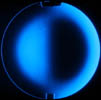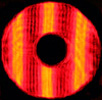October 28,
2010: A
Client's Story, Part 1 - Testing
Even in these days of apparently better optics available to amateurs, I
am still surprised by what comes through my doors.
On a cold, blustery October morning, a telescope owner arrived with his
32" primary and his secondary mirror.
Having
taken delivery of the telescope less than a year ago, he had
been
enjoying it, but his observations told him that something was wrong.
He had been assured by those involved with the construction
that
everything was fine. The experiences of other telescope
owners
seemed to tell him that "big mirrors just work like that".
Still,
he felt that something wasn't right. Star testing over many
nights of use showed
persistent, consistent undercorrection. In his own words:
"Over
the last week, I have had a couple of nights to compare the 12.5" and
32" side by side. The visual effects of the 32"
undercorrection
are obvious but most evident to me when performing lunar and planetary
observations. Not only is there no snap focus point with the 32", but
the difficulty in finding best focus is very
frustrating. Even at low magnification, (160x/5mm
exit
pupil), the need to focus through towards the inside of focus to
achieve "best sharpness" is quite obvious. Once this "best
focus/sharpness is achieved" the veiling glare that is present is
amazing (disgusting).... Stars in bright globulars are not
fine
dust like they are in the 12.5" at the same exit pupil and similar
magnification. Of course both scopes were collimated and
close to
ambient. Yes, the brightness and added color of the 32"
images
can be overwhelming and misleading as to optical quality, but image
sharpness/contrast of the smaller scope is without question
superior."
"I
had not actually compared the two scopes before because I know the
12.5" has a very good mirror that I can not find any obvious fault
with. I knew I would only be disappointed by the
comparison. I had been too busy convincing myself
and being
convinced by vendors that the disappointing performance of the 32" was
caused by thermals, seeing, or some other issue. It
has
been interesting to compare the two scopes and further educate myself
about the visual effects of optical aberrations."
I
had the opportunity to look through his 32" telescope
recently.
Images were generally good and stars were round, but star
testing
showed some correction error, and images lacked a "snap" that I was
used to seeing in other instruments. I
thought that this could possibly be a cooling issue, so we tried
another test.
Using
my Ronchi eyepiece, I could see the bands bend a little as they
"rolled" off the edge of the defocused star image. This told
me
something was not quite right, and we resolved to bench-test the optic
to separate issues from the optics from thermal and mechanical issues
of the telescope.
Back
in the shop, we set the primary mirror on the test stand, placed the
secondary mirror on a reference flat, left them to equilibrate, had
lunch, and returned for
testing.
Readings in hand, I analyzed the data and found a shocking 0.45
waves of undercorrection on the glass, and 0.9 waves on the wavefront!
This was the minimum P-V, with an accompanying transverse
error
of 18.5. This immediately verified the client's star testing
results,
and I was
stunned by the results. If I adjusted the radius of curvature
to
flatten the outer zone (as I would when testing a mirror that I was
working on), then the "hill" in the central portion of the mirror
became much higher.
Additionally, the mirror had serious coating
problems
and the extreme
outer edge was turned (a very narrow roll, not broad).
On
the positive side, the mirror was fairly smooth, and our star testing
had shown no serious figure-of-revolution problems. This was
not
of much consolation to the owner, though.
In
the photo below, you can see
the variations in the coating, forming a pattern across the mirror.
I do not know what the pattern is from. The
diffraction
ring is completely absent on the left, while bright (and a bit blurred
due to my camera/imaging setup for this shot) on the right. I
could see the outer ~1/8"-1/16" of the mirror was turned fairly
severly. I am not sure if this was seriously affecting the
images, but it could have been masked by the undercorrection and was
definitely thowing some light well out of the ideal spot.
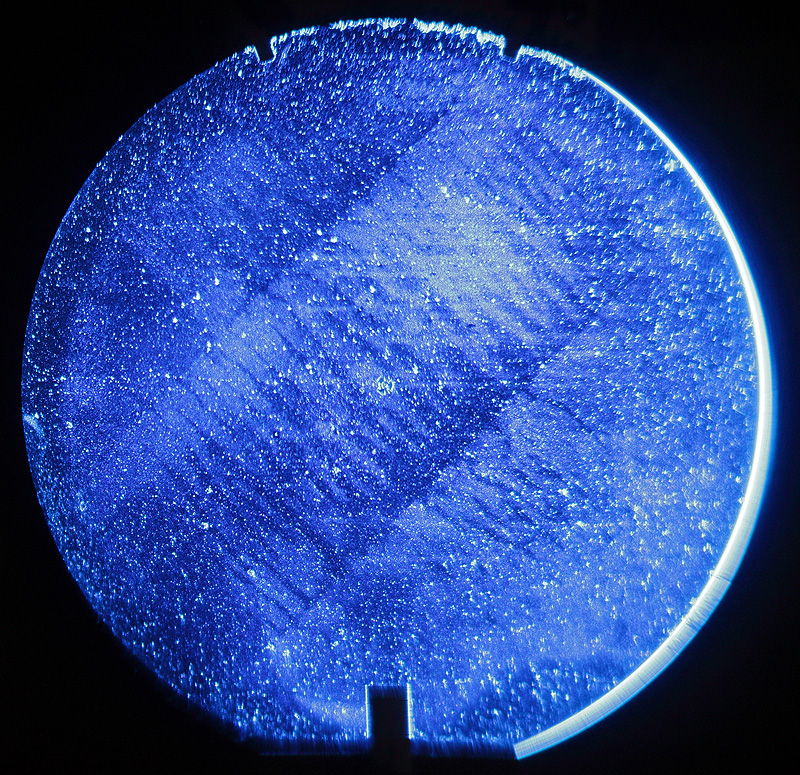
This
image shows the transparency of the coating. I placed a light
box
behind the primary to illuminate the central portion, and this is a
simple photo of the result. The three lightest "lines" are
where
someone's fingers were lightly pulled across the coating.
This
action should not have caused this much damage to the coating.
The three vertical features are the reflection of my camera tripod legs.
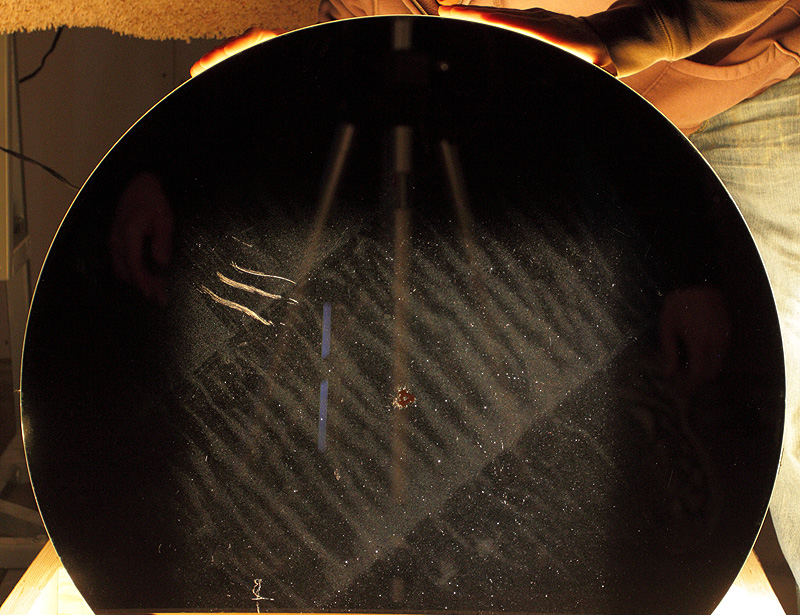
The
secondary had a pretty good coating, and the client had cleaned it
well.
Setting it directly on my partially-coated reference flat,
the
fringes looked like this.
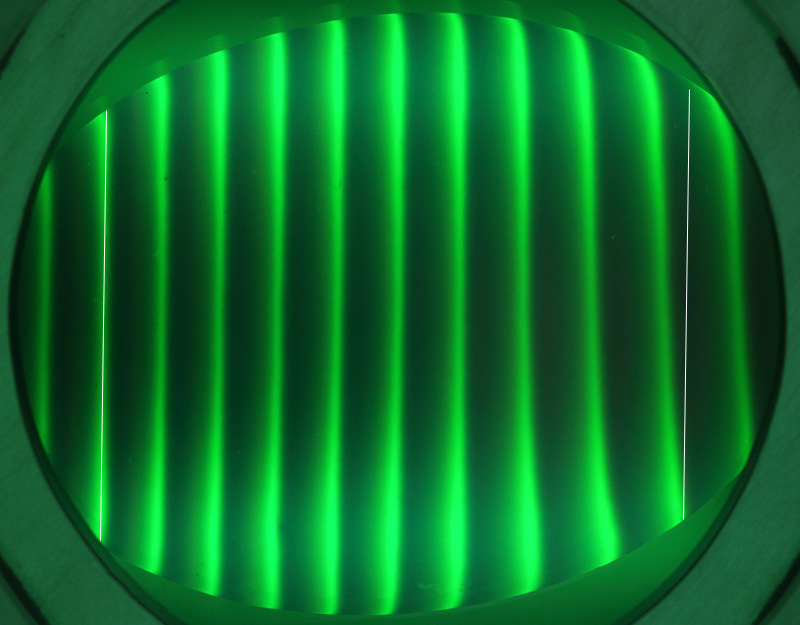
The
straight, white lines were added by me for clarity - they help show
that the fringes are not parallel or evenly spaced, and that on one
end, one
side of the secondary is at least 1/4 wave high
(the part at bottom right). There is also some concavity
along
the major axis, easily making it 1/2 wave at best. This is
not a
really bad flat, but it is not
setting any records, and is what I am used to seeing from
flats
in this size range.
Think you're getting a 1/20th or 1/30th wave flat in
your scope? Think again! Personally I look for
1/8th wave
quality from large secondaries - and if it is truly 1/8th wave and
smooth, it will do the job superbly.
What was the result of the client's visit? Early next year I will be
refiguring both the
primary and secondary mirrors.
Then, with new, better coatings
and improved figures, we'll reassess the telescope's performance and
post an update.
In his own words, again:
"I look forward to experiencing
the visual improvement after the
refigure. I am certain that it will be obvious.
Tight stars and a
definite (snap) focus point. It will also be interesting to
see how
much extra intricate nebular detail and color can be seen."
"Perhaps I
will be able to help somebody else with the same frustrations
in the future be able to trust their observations and
instincts. Far
too often customers are told they are crazy or there is no way the
mirror, binoviewers, binoculars, etc, could be bad."
I look forward to
experiencing it, too, and I hope some people learn from our experiences.
Please check back for future installements of "In
the Shop".
Mike
Lockwood
Lockwood Custom Optics
